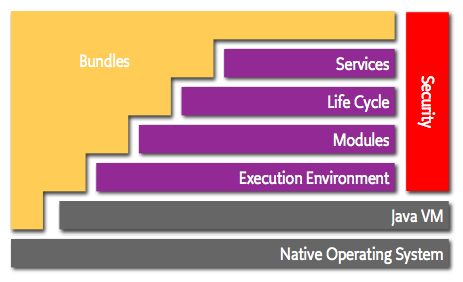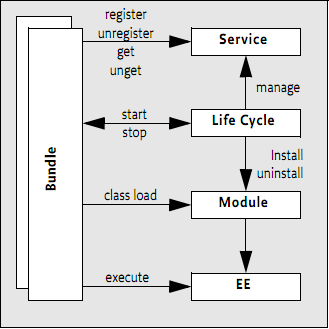Difference between revisions of "OSGi Concepts"
| Line 32: | Line 32: | ||
The core component of the OSGi Specifications is the OSGi Framework. The Framework provides a standardized environment to applications with the layers described above. | The core component of the OSGi Specifications is the OSGi Framework. The Framework provides a standardized environment to applications with the layers described above. | ||
| − | + | The most used implementations of [http://www.osgi.org/Specifications/HomePage OSGi Specifications] are [http://www.knopflerfish.org/ Knopflerfish] and [http://www.eclipse.org/equinox/ equinox] | |
<h4>[http://www.osgi.org/Release4/HomePage Interactions between layers]</h4> | <h4>[http://www.osgi.org/Release4/HomePage Interactions between layers]</h4> | ||
[[File:bundle-inter.png|400px|Interactions between layers]] | [[File:bundle-inter.png|400px|Interactions between layers]] | ||
Revision as of 09:50, 25 January 2011
Main Page · Course Description · Course Topics · Schedule, Students, Teams · Course Resources · Course Projects
The OSGi Alliance - Open Services Gateway initiative - is an open standards organization founded in March 1999 that originally specified and continues to maintain the OSGi standard. OSGi technology seems to be remarkably difficult to those unfamiliar with it.
Definitions:
OSGi enables the development of applications from components that could be:
- reusable
- dynamically composed
- hide their implementation
- communicate their dependencies and services
- 2. Bundle is the name for a component in the OSGi Architecture.
- 2. Bundle is the name for a component in the OSGi Architecture.
(generic bundle definition - a group of things fastened together for convenient handling[3] )
OSGi Framework The following list contains a short definition of the terms:
- Bundles - Bundles are the OSGi components made by the developers.
- Services - The services layer connects bundles in a dynamic way by offering a publish-find-bind model for plain old Java objects.
- Life-Cycle - The API to install, start, stop, update, and uninstall bundles.
- Modules - The layer that defines how a bundle can import and export code.
- Security - The layer that handles the security aspects.
- Execution Environments - Defines what methods and classes are available in a specific platform.
The core component of the OSGi Specifications is the OSGi Framework. The Framework provides a standardized environment to applications with the layers described above. The most used implementations of OSGi Specifications are Knopflerfish and equinox

